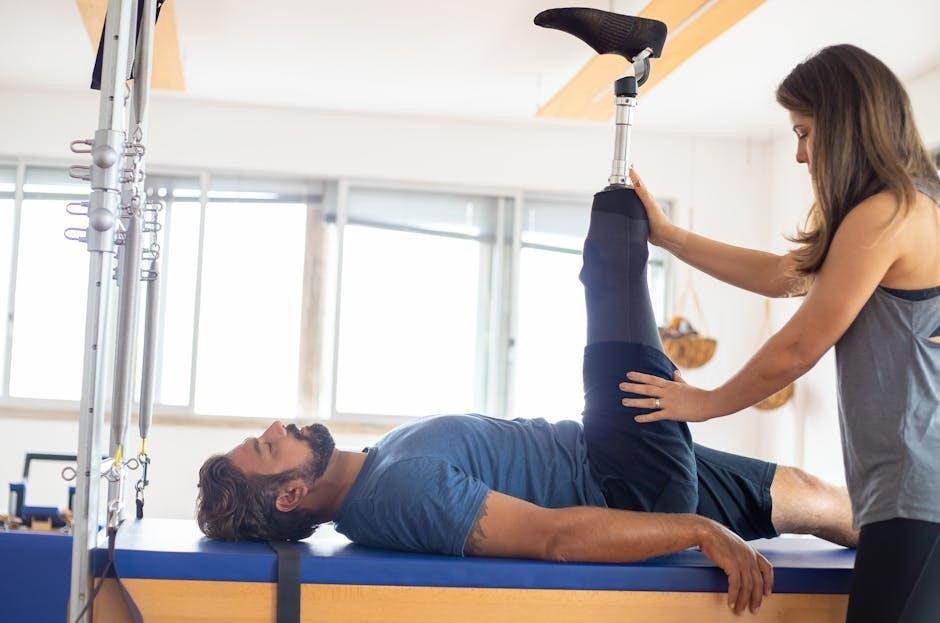The piriformis muscle is a deep, powerful muscle located beneath the gluteal muscles, playing a crucial role in hip flexibility and stability by enabling lateral rotation and stabilization.
1.1 What is the Piriformis Muscle?
The piriformis muscle is a flat, deep muscle located beneath the gluteal muscles, playing a vital role in hip movement and stability. It originates from the anterior surface of the sacrum and inserts onto the greater trochanter of the femur. This muscle is responsible for hip lateral rotation, stabilization, and assisting in extension. When tight or inflamed, it can compress the sciatic nerve, leading to pain and discomfort associated with piriformis syndrome or sciatica.
1.2 Importance of the Piriformis Muscle in Hip Flexibility and Stability
The piriformis muscle is essential for maintaining hip flexibility and stability, enabling smooth lateral rotation and supporting proper gait mechanics. Its role in stabilizing the hip joint ensures balanced movement and prevents excessive wear on surrounding tissues. Tightness or imbalance in this muscle can lead to reduced mobility and discomfort, emphasizing the importance of regular stretching to maintain optimal function and prevent conditions like piriformis syndrome or sciatica-related pain.

Benefits of Stretching the Piriformis Muscle
Stretching the piriformis muscle reduces tension, alleviates sciatica symptoms, and improves hip flexibility. It enhances mobility, prevents piriformis syndrome, and minimizes lower back discomfort, promoting overall well-being.
2.1 Reducing Tension and Muscle Discomfort
Stretching the piriformis muscle effectively reduces muscle tension and alleviates discomfort caused by tightness or knots. Regular stretching helps relax the muscle, improving blood flow and reducing stiffness. This can prevent muscle imbalances and promote a healthier hip joint. By targeting the piriformis, individuals can experience relief from chronic discomfort and improve their overall mobility and well-being. Incorporating these stretches into a daily routine can significantly reduce muscle tension and enhance quality of life.
2.2 Improving Mobility and Flexibility
Stretching the piriformis muscle enhances hip mobility and flexibility by loosening tight muscle fibers and improving joint range of motion. Regular stretching reduces stiffness, allowing for smoother hip movements and better overall functionality. Improved flexibility also supports physical activities, making it easier to perform daily tasks or engage in sports. By incorporating piriformis stretches, individuals can maintain healthy hip function and enjoy greater freedom of movement in their daily lives.
2.3 Preventing Piriformis Syndrome
Regular stretching of the piriformis muscle is essential for preventing piriformis syndrome, a condition causing pain and discomfort near the hip. Tight or inflamed piriformis muscles can irritate the sciatic nerve, leading to symptoms like numbness or tingling. By maintaining flexibility and strength, individuals can reduce the risk of developing this condition. Incorporating targeted stretches into a daily routine helps keep the muscle balanced, promoting optimal hip function and reducing the likelihood of piriformis-related issues over time.
2.4 Alleviating Sciatica Symptoms
Stretching the piriformis muscle can significantly alleviate sciatica symptoms by reducing tightness and pressure on the sciatic nerve. Sciatica often arises from a tight or inflamed piriformis muscle compressing the nerve, causing pain and discomfort. Regular stretching helps loosen the muscle, improve blood flow, and reduce nerve irritation. This can lead to less pain, improved mobility, and faster recovery. Incorporating piriformis stretches into a daily routine can effectively manage sciatica and enhance overall lower back and hip health.

Common Piriformis Stretches
Explore effective stretches targeting the piriformis muscle to enhance flexibility, relieve tension, and improve hip mobility. These exercises are simple yet impactful for everyday practice.
3.1 Seated Piriformis Stretch
The seated piriformis stretch is a simple and effective exercise to target the piriformis muscle. Sit on the floor with your legs extended, then cross one leg over the other, placing your ankle on the opposite knee. Gently lean forward to feel a stretch in the buttock area. This stretch helps relieve tension, improves hip mobility, and can alleviate sciatica symptoms. Hold for 20-30 seconds and repeat on the other side for balanced relief.
3.2 Supine Piriformis Stretch
The supine piriformis stretch is performed while lying on your back, making it ideal for those with mobility limitations. Bend both knees and place the ankle of the affected leg onto the opposite knee. Gently pull the unaffected knee toward your chest until a stretch is felt in the buttock. This stretch targets the piriformis muscle effectively, providing relief from tension and improving hip joint mobility. Hold for 20-30 seconds and switch sides for a balanced stretch.
3.3 Figure-4 Piriformis Stretch
The figure-4 stretch is a highly effective piriformis stretch performed while lying on your back. Bend one knee and cross the ankle of the affected leg over the opposite knee, forming a “figure-4” shape. Gently pull the unaffected leg toward your chest until a stretch is felt in the buttock and hip area. This stretch targets the piriformis muscle directly, helping to relieve tension and sciatica symptoms. Hold for 20-30 seconds and repeat on the other side for optimal results.
3.4 Standing Piriformis Stretch
The standing piriformis stretch is an excellent option for those who prefer stretching upright. Stand with your feet shoulder-width apart, hands on a wall for balance. Bend one knee to a 90-degree angle, keeping your foot behind you. Lean forward slightly until a stretch is felt in the buttock and hip area. Hold for 20-30 seconds, then switch sides; This stretch improves hip mobility and helps alleviate sciatica symptoms caused by piriformis tightness. Perform it gently to avoid discomfort.
3.5 Buttock Stretch for Piriformis Relief
The buttock stretch targets the piriformis muscle to relieve tension and pain. Sit on the floor with your legs crossed, placing one hand on the knee of the crossed leg. Gently pull your knee toward your opposite shoulder until a stretch is felt in the buttock and hip area. Hold for 20-30 seconds, then switch sides. This stretch helps reduce muscle tension and improves flexibility. Perform it gently to avoid discomfort and repeat 2-3 times for optimal relief.
3.6 IT Band Stretch
The IT band stretch helps alleviate piriformis tension by targeting the iliotibial tract. Stand with your right side near a wall for balance. Cross your left foot over your right thigh, forming a figure-4 shape. Lean toward the wall gently until a stretch is felt along the outer thigh and hip. Hold for 20-30 seconds, then switch sides. This stretch improves flexibility and reduces tightness in the IT band, which often contributes to piriformis discomfort. Perform it 2-3 times for best results.

Advanced Piriformis Stretches
These stretches target deeper muscle engagement and flexibility. Ideal for experienced individuals, they incorporate dynamic movements and prolonged holds to maximize piriformis relief and hip mobility.
4.1 Piriformis Stretch on Hands and Knees
Start on hands and knees, with knees hip-width apart. Lift one knee outward, keeping the foot flexed, until a gentle stretch is felt in the buttock. Hold for 20-30 seconds, then switch sides. This stretch targets the piriformis muscle effectively, relieving tension and improving hip mobility. It is particularly beneficial for those with tightness or discomfort in the glutes. To enhance the stretch, gently press the knee outward while maintaining a stable core. Repeat 2-3 times for optimal relief.
4.2 Long-Sit Stretch for the Piriformis
Sit on the floor with legs extended straight in front. Cross one foot over the opposite knee, keeping the spine neutral. Gently lean forward from the hips until a stretch is felt in the buttock. Hold for 20-30 seconds, then switch sides. This stretch is ideal for targeting the piriformis while maintaining hip stability. It improves mobility and relieves tightness. For best results, keep movements gentle and avoid bouncing. Repeat 2-3 times for each side to enhance flexibility and comfort.
4.3 Supine Hip Rotation Stretch
Lie on your back with knees bent and feet flat on the floor. Cross one knee toward your chest, keeping the other foot grounded. Gently rotate your hip downward until a stretch is felt in the buttock. Hold for 30 seconds, then slowly release. Repeat 2-3 times on each side. This stretch targets the piriformis muscle effectively while maintaining spinal alignment. It enhances hip mobility and reduces muscle tension. Perform with controlled movements to maximize benefits and avoid discomfort.

Variations and Modifications
Explore gentle stretches for pain relief and modify routines based on flexibility. Incorporate dynamic or static stretching to suit fitness levels and goals effectively.
5.1 Gentle Stretches for Pain Relief
Gentle stretches are ideal for individuals experiencing piriformis discomfort or pain. These low-intensity exercises focus on controlled movements to ease tension without overextending the muscle. Techniques include seated or supine stretches that target the piriformis while minimizing strain on the lower back. Incorporating deep breathing can enhance relaxation and reduce muscle tightness. Modified versions of stretches, such as shorter holds or reduced depth, can be tailored to individual pain levels. Prioritizing gentle movements ensures a safe and effective approach to alleviating discomfort.
5.2 Dynamic vs. Static Stretching
Dynamic and static stretching differ in approach and benefits for the piriformis muscle. Dynamic stretching involves active movements, such as hip rotations or leg swings, to warm up and prepare the muscle for activity, enhancing flexibility and range of motion. Static stretching, like holding a seated or supine stretch, targets the piriformis by lengthening the muscle and relieving tension, often used post-exercise for therapeutic benefits. Both methods are valuable, with dynamic stretches ideal for preparation and static stretches for relaxation and pain relief, each serving distinct purposes in a stretching routine.

Safety Precautions and Tips
Always listen to your body, avoid overstretching, and warm up before starting. Use proper form and stop if pain occurs to prevent injury.
6.1 Avoiding Lower Back Strain
To avoid lower back strain during piriformis stretches, maintain proper posture and avoid rounding or arching your back excessively. Keep movements controlled and slow, as jerky motions can strain muscles. Engage your core to stabilize your body and prevent unnecessary pressure on the lower back. If discomfort arises, modify the stretch by bending the knee slightly or using a prop for support. Prioritize gentle, sustained stretches over aggressive movements to protect your spine and ensure safe practice.
6.2 Monitoring Pain Levels During Stretching
Monitoring pain levels during piriformis stretches is crucial to avoid injury or worsening discomfort. Stop immediately if sharp pain occurs, as mild discomfort is acceptable but severe pain is not. Adjust the intensity or position to stay within a tolerable range. Focus on gentle, controlled movements to ensure safety and effectiveness. If pain persists or worsens, consult a healthcare professional for guidance. Prioritize comfort and progress gradually to avoid setbacks.

Downloadable Piriformis Stretch PDF Guide
A comprehensive guide featuring detailed stretches, diagrams, and routines to target the piriformis muscle effectively. Perfect for home use, it ensures consistent practice and progress tracking.
7.1 Features of the PDF Guide
The downloadable PDF guide offers a structured approach to piriformis stretching, featuring step-by-step instructions, high-quality images, and customizable routines. It includes variations for different fitness levels, ensuring accessibility for everyone. The guide also provides tips for proper form, breathing techniques, and avoiding injury. With a focus on progressive overload, it helps users gradually increase flexibility and strength. Perfect for home or gym use, the PDF is portable and easy to follow, making it an essential tool for consistent practice and measurable results.
7.2 How to Use the PDF for Daily Routine
Incorporate the PDF guide into your daily routine by setting a consistent schedule, such as 10-15 minutes in the morning or evening. Start with gentle stretches, gradually increasing intensity. Warm up with light cardio before stretching to enhance effectiveness. Follow the guide’s sequence, focusing on proper form and deep breathing. Track progress weekly, adjusting stretches as needed. End with a cool-down to relax muscles and promote recovery. Consistency and patience are key to achieving long-term benefits.

Real-Life Applications of Piriformis Stretches
Piriformis stretches benefit runners by reducing tightness and sciatica, while office workers can alleviate muscle tension from prolonged sitting, enhancing overall hip mobility and comfort.
8.1 Stretches for Runners
Runners often experience piriformis tightness due to repetitive hip flexion and extension. Incorporating piriformis stretches, such as the seated piriformis stretch or figure-4 stretch, can help reduce muscle tension and improve hip mobility. These stretches are especially beneficial after long runs or sprinting sessions, as they prevent piriformis syndrome and sciatica-like symptoms. Regular stretching can also enhance running performance by promoting better hip alignment and reducing the risk of overuse injuries. Many runners find these stretches essential for maintaining optimal hip health and overall athletic performance.
8.2 Stretches for Office Workers
Office workers often suffer from piriformis tightness due to prolonged sitting. Simple stretches like the seated piriformis stretch or figure-4 stretch can be done at a desk to relieve tension. These exercises help improve circulation, reduce muscle stiffness, and prevent piriformis syndrome. Incorporating these stretches every 30-60 minutes can enhance posture, reduce discomfort, and promote overall hip health, making them ideal for individuals with sedentary jobs. Regular practice can significantly improve mobility and prevent long-term muscle imbalances caused by sitting for extended periods.

Incorporating Piriformis Stretches into Daily Routine
Start with 5-10 minute sessions daily, focusing on gentle stretches. Gradually increase duration as flexibility improves. Consistency is key for long-term hip health and pain prevention.
9.1 Frequency and Duration of Stretching
Aim to stretch the piriformis muscle 3-4 times weekly for optimal results. Begin with 10-15 minute sessions, focusing on gentle, controlled movements. For best flexibility, incorporate stretches into your morning or post-workout routine. Start with shorter holds of 20-30 seconds and gradually increase to 60 seconds as comfort allows. Consistency is key to reducing muscle tension and improving mobility. Adjust frequency based on physical activity levels, ensuring proper form to avoid injury and maximize effectiveness.
9.2 Combining with Other Exercises
Enhance your routine by pairing piriformis stretches with complementary exercises. Incorporate strength training for the core and glutes to improve stability. Add cardio activities like cycling or swimming to promote blood flow and flexibility. Yoga poses, such as downward dog or pigeon pose, can also complement piriformis stretches. For optimal results, combine stretching with foam rolling or massage to release tension. A balanced approach ensures comprehensive hip health and prevents muscle imbalances. Tailor your combinations based on fitness goals and current activity levels for the best outcomes.

Tracking Progress and Adjusting the Routine
Monitor flexibility and pain relief regularly. Adjust stretches based on progress, increasing intensity or duration as needed. Tailor the routine to maintain improvement and prevent plateaus.
10.1 Monitoring Flexibility and Pain Relief
Regularly assess improvements in flexibility and reductions in pain. Use a journal to track progress, noting increased range of motion and decreased discomfort. Measure how stretches impact daily activities and overall comfort. Adjust routines based on feedback, ensuring consistent practice leads to sustained relief. Celebrate small victories to stay motivated and maintain a proactive approach to managing piriformis-related discomfort effectively.
10.2 Adjusting Stretches Based on Progress
As flexibility and strength improve, gradually increase the intensity and duration of stretches. Introduce dynamic stretches to enhance mobility further. Extend the hold time for each stretch to deepen the impact. Incorporate variations or advanced stretches to challenge muscles. Tailor the routine to individual progress, ensuring continuous improvement. If progress stalls, consult a physical therapist for personalized adjustments. Regularly update the stretching plan to maintain effectiveness and prevent plateaus.
Regular piriformis stretching enhances flexibility, alleviates discomfort, and promotes overall well-being. Consistent practice ensures long-term benefits, making it essential to incorporate these exercises into daily routines for optimal results.
11.1 Summary of Benefits
Stretching the piriformis muscle offers numerous benefits, including reduced muscle tension, improved mobility, and enhanced hip flexibility. It helps prevent piriformis syndrome, alleviates sciatica symptoms, and supports overall lower body alignment. These exercises are particularly beneficial for individuals with active lifestyles, such as runners or cyclists, as well as those with desk jobs. Incorporating piriformis stretches into a daily routine can significantly improve comfort and reduce the risk of injury. Consistent practice ensures sustained benefits and better long-term musculoskeletal health.
11.2 Encouragement for Consistent Practice
Consistency is key to experiencing lasting benefits from piriformis stretches. By incorporating these exercises into your daily routine, you can maintain hip flexibility, prevent discomfort, and enhance overall mobility. Even a few minutes each day can lead to significant improvements over time. Stay motivated by tracking your progress and celebrating small victories. The downloadable PDF guide offers a structured plan to help you stay committed. Remember, regular stretching is an investment in your long-term health and well-being.
